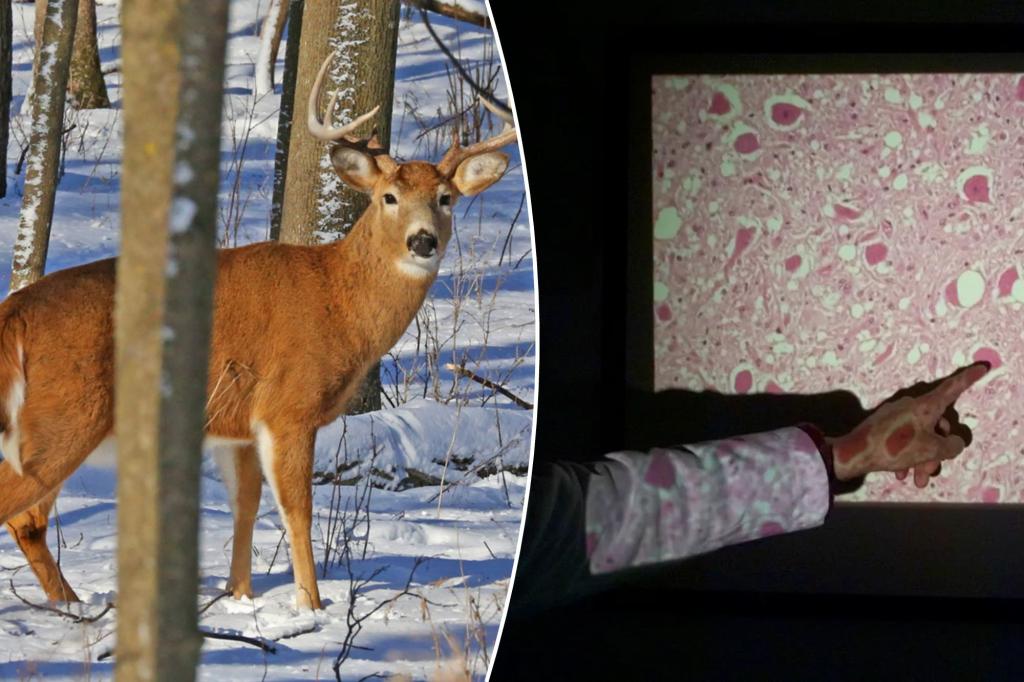Despite ongoing efforts to reduce its spread in the U.S. and abroad, deadly chronic wasting disease (CWD) remains a threat, with no vaccine or cure.
In 2005, “zombie deer” disease struck New York after several deer infected with CWD escaped from a fenced pen in Oneida County, a largely rural area in upstate New York.
Only a quick and aggressive culling operation by the New York Department of Environmental Conservation (which resulted in the killing of hundreds of deer, with the cooperation of local hunters) was able to stop the outbreak.
To date, New York is the only state to have eliminated CWD from its deer, elk and moose population.
But CWD has continued to spread around the world (including a recent case in Yellowstone National Park) and many regions of the country are on alert for the disease in wild and penned animals.
How chronic wasting develops
Deer, elk and other animals across the country are falling victim to chronic wasting disease. Star Tribune via Getty Images
Medical experts know chronic wasting disease as a prion disease, a group of rare progressive neurological disorders that affect humans and animals.
Other prion diseases include Creutzfeldt-Jakob disease and bovine spongiform encephalopathy, also known as “mad cow disease.”
The disease causes sponge-like holes to develop in the brain of an infected animal, as well as affecting the cerebrospinal fluid and other body tissues.
And although there have been no cases of CWD spreading to humans, some studies suggest that it poses a risk to certain types of primates that come into contact with body fluids from infected animals.
“These studies raise concerns that there may also be a risk to people,” the Centers for Disease Control and Prevention said in a 2021 report.
That same year, Pennsylvania reported an outbreak of CWD in deer just a few miles from the New York state border. As of this month, the CDC reports that the disease has been found in 31 states, as well as three Canadian provinces, northern Europe and South Korea.
How CWD spreads
 Chronic wasting disease causes sponge-like holes to develop in the brain of an infected animal. Star Tribune via Getty Images
Chronic wasting disease causes sponge-like holes to develop in the brain of an infected animal. Star Tribune via Getty Images
Prion diseases like CWD have a long incubation period, which is especially concerning because an infected animal appears healthy for up to two years before showing symptoms, during which time it can transmit the disease to other animals.
CWD and other prion diseases are transmitted through body fluids and contaminated soil, plants, food, or water. As the disease progresses through the brain and nervous system, infected animals may show symptoms including:
- drastic weight loss (wasting)
- stumbles and lack of coordination
- languor
- drooling
- excessive thirst or urination
- floppy ears
- lack of fear of people
Recommended precautionary measures
Hunters are asked to be on the lookout for deer, elk, moose or other members of the cervid family showing any of these symptoms.
Additionally, anyone preparing, skinning, or cutting meat should wear nitrile, rubber, or latex gloves.
To control the spread of CWD, New York and most other states have strict regulations against the importation of live deer and other cervids from out of state, as well as prohibitions against the importation of carcasses and byproducts.
People are also not allowed to feed wild deer because most human foods are unhealthy for deer and because concentrating the animals at a single feeding site can help spread CWD.
Categories: Trending
Source: vtt.edu.vn
